France’s fascinating, confusing ‘Little Britain’ doesn’t feel French
The French region of Brittany is famed for its insularity and Celtic roots, and is culturally closer in many ways to Ireland, Scotland and Wales.
And sure enough, a first visit leaves me confused. There are the typical boulangeries and cafes but otherwise… is this place even French?
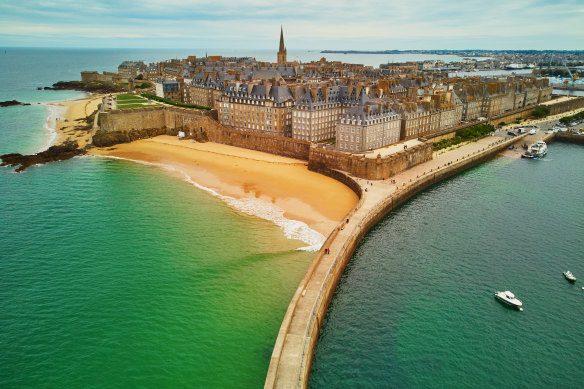
The historic walled citadel of Saint-Malo.Credit: iStock
There are Breton flags flying on poles, the Breton language blares from the radio and there appears to be a remnant separatist movement with the occasional graffitied slogan Breizh Libre, “Free Brittany”.
In a bold nationalist move, they sell their own Coke alternative, “Breizh Cola”.
The people look strangely familiar, with the same compact build and fair, freckled complexions of the many Australians with Celtic ancestry.
On a warm summer night, the sound of bagpipes emanates from a local festival. Then there are references to Celtic fairy folklore and mysterious granite standing stones dotted throughout the countryside – similar to Stonehenge, only much more extensive.
This Franco-Celtic cultural blend, both familiar and discordant, sparks a curiosity to know more. It will take time, and more visits, before I start to get the measure of it.
Brittany is a large region – the north coastline, which includes the historic walled citadel of Saint-Malo, borders the English Channel, while the far west department of Finistere, which literally means “world’s end”, is said to be the most authentic.
But I’m exploring Southern Brittany and the Gulf of Morbihan, known for its rugged coastline and windswept sandy beaches. It has long been a favoured summer holiday destination for Parisians, but in recent years its mild climate has made it even more popular after a series of scorching hot summers on the Côte d’Azur. The Gulf of Morbihan, more than twice the size of Sydney Harbour, is fringed with pretty villages sheltered from the Atlantic Ocean, and has about 40 islands including Belle-Ile with its jagged cliffs and grand lighthouse (you’ve no doubt seen a poster of the lighthouse in a storm at a doctor’s or dentist’s surgery).
But the interior holds the secrets of its fascinating history. Just inland from the touristy beach town of Carnac is the world’s biggest collection of megaliths, or “menhirs”, with about 3000 granite standing stones placed in alignments. The most ancient of them date back more than 6000 years, millennia before Stonehenge.
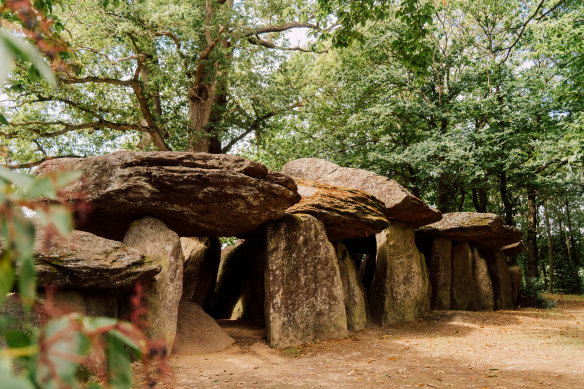
Just inland from the touristy beach town of Carnac is the world’s biggest collection of megaliths.
You need to drive, rather than walk, around them to understand the sheer scale, with rows stretching more than a kilometre. There are also numerous dolmens (stone tombs), and burial mounds scattered around the countryside.
Although Obelix (from the Franco-Belgian comic book series Asterix) is always pictured lugging around a menhir, the stones were not erected by the Celts but their neolithic ancestors.
These ancient monuments are indeed so numerous that a century ago it was not unusual for a local farm to use an ancient dolmen as a chicken coop; or to hive off one of the smaller menhirs to help prop up a crumbling building.
Like Stonehenge, the purpose of the megaliths is still being debated, and there are theories about whether they are aligned to astronomical movements or act as a boundary marker.
Mysticism surrounding the megaliths fuelled local folklore, from Cornish and Welsh settlers who started migrating to Brittany (literally “Little Britain”) in the fifth century. There are legends of mischievous “korrigan” fairies dancing around the standing stones, and superstitions about black cats and witchcraft.
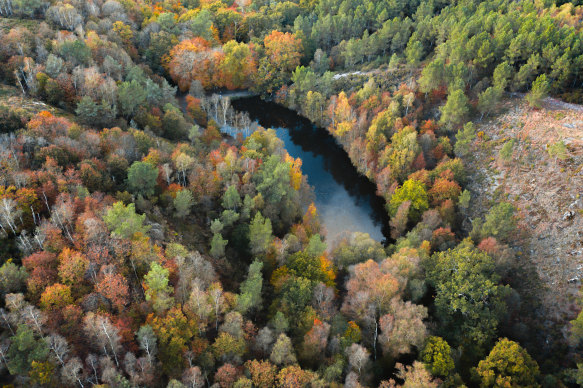
Broceliande forest is connected by King Arthur’s legend to sites in Cornwall and Wales.
Only an hour’s drive north-east from the standing stones of Carnac is the forest of Paimpont, identified as the enchanted Broceliande forest of Arthurian literature. Merlin the magician was said to have met Viviane, the Lady of the Lake, at the Barenton fountain, and an ancient dolmen in the forest was long thought to be his tomb.
There are elements of tourist trappery here, and you may want to avoid the walking tour by a harp-playing guide in period costume. Some of the purported Arthurian sites, such as the Barenton fountain, are underwhelming, but the forest is definitely worth a visit for its walking trails and ancient oak trees.
Broceliande in Brittany, connected by King Arthur’s legend to sites in Cornwall and Wales, shows how closely threaded the cultures are.
The Breton language is indeed related to Cornish and Welsh, and after becoming almost extinct in the past century has had a revival, now being taught in primary schools and featured in official signage.
Thankfully, the Brittany separatist movement has given up the bombing campaigns by paramilitary groups which included blasting part of the ground floor of the palace of Versailles in 1978 and, tragically, killing a fast-food worker in 2000.
But regional identity remains strong, with many considering themselves to be Bretons first, and French second.
Brittany comes together with its fellow Celtic “nations” every summer in the town of Lorient for the Interceltic Festival, where there are bagpipes aplenty and a full roster of musical acts over six days.
On a smaller scale, there are local gatherings in summer where Celtic culture is on proud display.
At a typical fest noz in the village of Locoal, we drink beer in plastic cups and enjoy bowls of moules frites (mussels with fries) and pork sausages wrapped in buckwheat galettes, and then join in traditional circle dances. What is impressive is that young and old participate enthusiastically in these dances – even my teenager is persuaded to join.
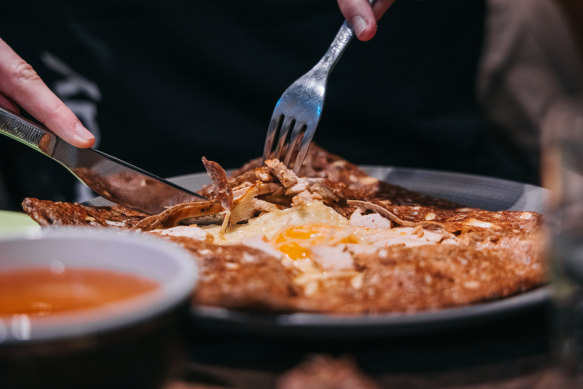
Savoury buckwheat galettes are a favourite.
Brittany has spawned its own unique gastronomic traditions, most famously sweet crepes, and you can eat them at the ubiquitous creperie restaurants in every village. But I’ve become obsessed with their savoury equivalent, buckwheat galettes, filled with anything from ham and cheese to mushrooms or seafood, and always accompanied by local cider.
I also can’t resist a kouign-amann, a pastry disc layered with an obscene amount of caramelised butter and sugar, and the far Breton, a custardy slab dotted with prunes. The region is also known for its salted butter caramel and pure butter biscuits. There are good local cheeses such as the Saint Paulin but really, it is all about the butter in Brittany.
Southern Brittany is particularly known for its oysters, with several farms in the Gulf of Morbihan that cultivate the native Belon (flat) variety. The Belon oyster was previously endangered but is now enjoying a resurgence, and is much appreciated for its distinctive hazelnut taste.
My partner’s great indulgence is to buy a dozen unshucked oysters direct from the producer for a mere €6 ($10). With a glass of Entre-Deux-Mers (a classic dry white wine costing a few euros a bottle from the supermarket) and a hunk of baguette, he’s yet to find a better meal.
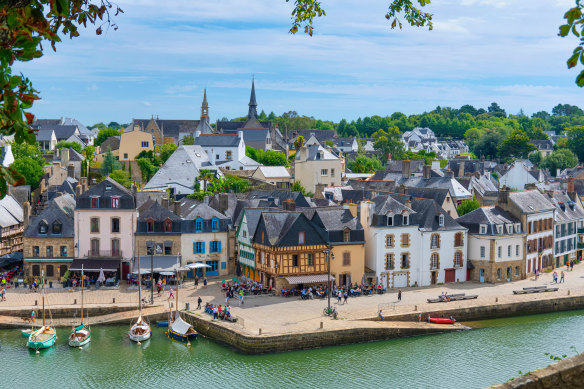
Port de Saint-Goustan, Auray.Credit: Getty Images
If shucking them yourself is too difficult, many of the co-ops offer on-site degustation, which can be as rustic as a couple of foldout chairs next to the boat ramp.
For a more refined experience, Maison Quintin, in the pretty town of Saint-Philibert, serves a degustation menu including shellfish and cooked dishes on a terrace in the summer months, and also offers cheerful and homely accommodation.
Every region of France boasts well-preserved medieval towns, and southern Brittany is no different.
The town of Auray has a historic port, half-timbered houses and winding cobblestone streets. Every Monday it has a lively market selling everything from clothing and jewellery to fresh produce. I stock up on strawberries in season; exquisitely perfumed and so delicate they virtually need to be eaten on the spot. The nearby town of Vannes is larger but also a charming spot for lunch, with medieval gates and a boat harbour.
Where I’ve come to get the best feel for Breton culture is the marshlands just inland from the Gulf of Morbihan. Influenced by strong tides, the landscape shifts and I can sense the remoteness of a region that was disconnected from France, let alone the rest of Europe, for centuries.
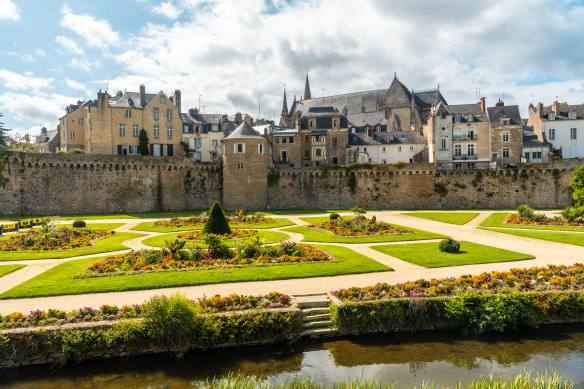
The city walls of Vannes, a charming spot for lunch.Credit: iStock
In these liminal spaces where there are ancient dolmens and megaliths, I can see why myths and legends arose and how Christianity, although entrenched, didn’t quite manage to suppress pagan superstitions.
Sure, Brittany can offer a delightful summer holiday of exploring its coastline while enjoying its oysters, crepes and cider. But travelling off-season, exploring the interior and taking time to understand its layers of neolithic history and Celtic culture, is also deeply rewarding.
But is Brittany French? Oui … et non.
The details
Visit
Brittany has two international airports, at Rennes and Nantes, with connections to European cities. These cities, as well as the towns of Vannes and Auray, are well connected to Paris by TGV. The best way to see southern Brittany is by hiring a car to explore at leisure the megaliths of Carnac, Paimpont forest (Broceliande) and the villages and oyster farms around the Gulf of Morbihan. Touring southern Brittany can be easily combined with a trip to the Loire Valley, 3½ hours’ drive to the south-east.
Stay
Accommodation options in Southern Brittany and the Gulf of Morbihan include gites (villas) and bed and breakfasts. See brittanytourism.com
The writer travelled at her own expense.
Sign up for the Traveller Deals newsletter
Get exclusive travel deals delivered straight to your inbox. Sign up now.